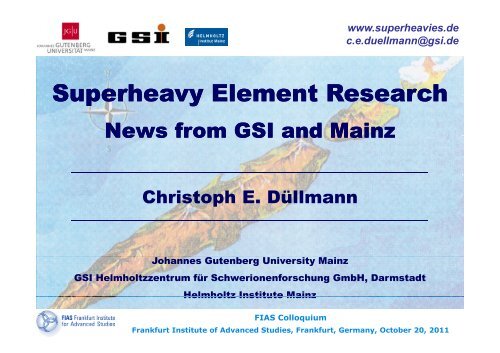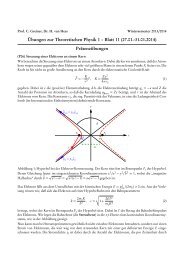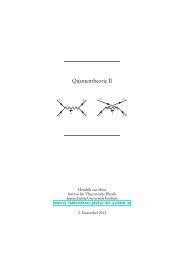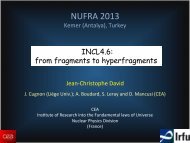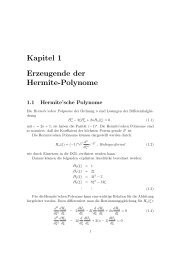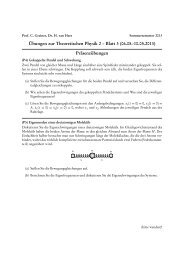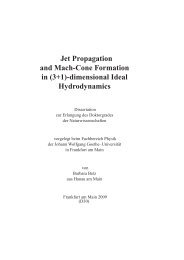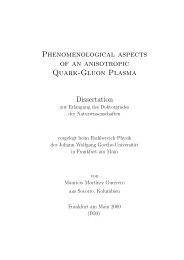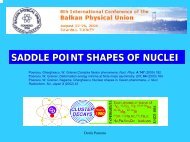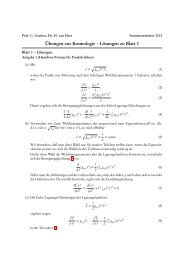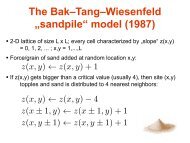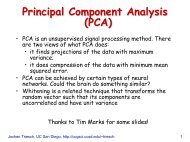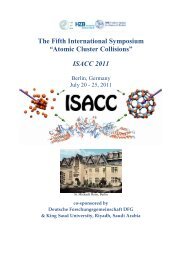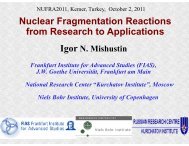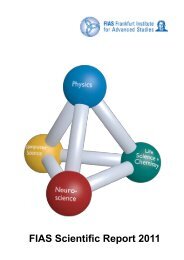Superheavy Element Research Superheavy Element Research
Superheavy Element Research Superheavy Element Research
Superheavy Element Research Superheavy Element Research
Create successful ePaper yourself
Turn your PDF publications into a flip-book with our unique Google optimized e-Paper software.
www.superheavies.de<br />
c.e.duellmann@gsi.de<br />
<strong>Superheavy</strong> <strong>Element</strong> <strong>Research</strong><br />
News from GSI and Mainz<br />
Christoph E. Düllmann<br />
Johannes Gutenberg University Mainz<br />
GSI Helmholtzzentrum für Schwerionenforschung GmbH, Darmstadt<br />
Helmholtz Institute Mainz<br />
FIAS Colloquium<br />
Frankfurt Institute of Advanced Studies, Frankfurt, Germany, October 20, 2011
The next 60 minutes:<br />
• <strong>Superheavy</strong> elements – Brief introduction, introduction status of<br />
the field<br />
• Facilities + program at GSI, U. Mainz, HIM<br />
• <strong>Research</strong> at the TASCA gas-filled recoil separator<br />
– Physics Example<br />
Search for <strong>Element</strong> 120<br />
– Chemistry Example<br />
<strong>Element</strong> 114: noble metal or noble gas?<br />
• Bi Brief fwrap-up<br />
Ch.E. Düllmann – <strong>Superheavy</strong> element research – FIAS Colloquium – Frankfurt Institute for Advanced Studies, Frankfurt – October 20, 2011
82<br />
50<br />
Peak of<br />
Calcium<br />
20<br />
Map of the Nuclear Landscape<br />
Peak of Tin<br />
Uranium Summit<br />
Peak of Lead<br />
20 82 126<br />
Flerov & Ilyinov (1986)<br />
Ch.E. Düllmann – <strong>Superheavy</strong> element research – FIAS Colloquium – Frankfurt Institute for Advanced Studies, Frankfurt – October 20, 2011
Potential<br />
ene ergy / MMeV<br />
Influence of shell effects on fission barrier<br />
2.5 MeV<br />
~0.5 MeV LD + shell<br />
no barrier!<br />
Cf<br />
250 50<br />
98 152<br />
LD 250 25098 98152<br />
SSg<br />
268 268106162 106 162<br />
298 114184<br />
298<br />
114 114184<br />
macroscopic barrier:<br />
Disappears at Z ~ 104!<br />
Deformation β2 after A. Sobiczewski / S. Hofmann<br />
Ch.E. Düllmann – <strong>Superheavy</strong> element research – FIAS Colloquium – Frankfurt Institute for Advanced Studies, Frankfurt – October 20, 2011
Potential<br />
ene ergy / MMeV<br />
Influence of shell effects on fission barrier<br />
LD + shell<br />
no barrier!<br />
Cf<br />
250 50<br />
98 152<br />
LD 250 25098 98152<br />
SSg<br />
268 268106162 106 162<br />
298 114184<br />
298<br />
114 114184<br />
macroscopic barrier:<br />
Disappears at Z ~ 104!<br />
with shell structure:<br />
spherical � deformed ground state<br />
fi fission i bbarrier i iis also l > 0 ffor<br />
elements with Z �104.<br />
some fission barriers have<br />
complicated shapes, multiplyhumped<br />
elements that exist only thanks<br />
to shell effects:<br />
superheavy elements<br />
Deformation β2 after A. Sobiczewski / S. Hofmann<br />
Ch.E. Düllmann – <strong>Superheavy</strong> element research – FIAS Colloquium – Frankfurt Institute for Advanced Studies, Frankfurt – October 20, 2011
~114 –<br />
126 (?)<br />
82<br />
50<br />
20<br />
Map of the Nuclear Landscape<br />
Island of Stability<br />
20 82 126<br />
184<br />
Ch.E. Düllmann – <strong>Superheavy</strong> element research – FIAS Colloquium – Frankfurt Institute for Advanced Studies, Frankfurt – October 20, 2011
Cross Sections in Hot / Cold / 48 Ca Induced Fusion Reactions<br />
1 pb: ~1-2 Events per Week<br />
Compilation: A. Yakushev, Habilitation thesis, TU Munich, 2009<br />
Ch.E. Düllmann – <strong>Superheavy</strong> element research – FIAS Colloquium – Frankfurt Institute for Advanced Studies, Frankfurt – October 20, 2011
Cross Sections in Hot / Cold / 48 Ca Induced Fusion Reactions<br />
Compilation: A. Yakushev, Habilitation thesis, TU Munich, 2009<br />
Ch.E. Düllmann – <strong>Superheavy</strong> element research – FIAS Colloquium – Frankfurt Institute for Advanced Studies, Frankfurt – October 20, 2011
Unique Combination for SHE Studies<br />
ECR +<br />
Stable<br />
UNILAC targets<br />
Beam<br />
TRIGA-<br />
Actinide<br />
targets g<br />
-LASER LASER<br />
Radiochem.<br />
-TRAP labs<br />
SHIP<br />
TASCA<br />
Chemistry<br />
SHIPTRAP<br />
TASISpec<br />
Chemical<br />
theory<br />
Ch.E. Düllmann – <strong>Superheavy</strong> element research – FIAS Colloquium – Frankfurt Institute for Advanced Studies, Frankfurt – October 20, 2011
HIM – The New Helmholtz Institute Mainz<br />
HIM Director: Frank Maas<br />
-<br />
-J. Dvorak (IRiS)<br />
(currently on leave of absence)<br />
-<br />
Chemistry Physics<br />
CED N.N.<br />
Toward a dedicated cw LINAC for SHE; ...<br />
Ch.E. Düllmann – <strong>Superheavy</strong> element research – FIAS Colloquium – Frankfurt Institute for Advanced Studies, Frankfurt – October 20, 2011
Toward A New Accelerator for SHE <strong>Research</strong><br />
ps<br />
sity / pp<br />
m Intens<br />
Beam<br />
Pulsed<br />
0 10 20 30 40<br />
Time / ms<br />
Ch.E. Düllmann – <strong>Superheavy</strong> element research – FIAS Colloquium – Frankfurt Institute for Advanced Studies, Frankfurt – October 20, 2011
Toward A New Accelerator for SHE <strong>Research</strong><br />
ps<br />
sity / pp<br />
m Intens<br />
Beam<br />
Pulsed �� �� cw Beams<br />
0 10 20 30 40<br />
Time / ms<br />
Ch.E. Düllmann – <strong>Superheavy</strong> element research – FIAS Colloquium – Frankfurt Institute for Advanced Studies, Frankfurt – October 20, 2011
Toward A New Accelerator for SHE <strong>Research</strong><br />
ps<br />
sity / pp<br />
m Intens<br />
Beam<br />
Pulsed �� �� cw Beams<br />
0 10 20 30 40<br />
Time / ms<br />
Ch.E. Düllmann – <strong>Superheavy</strong> element research – FIAS Colloquium – Frankfurt Institute for Advanced Studies, Frankfurt – October 20, 2011
Toward A New Accelerator for SHE <strong>Research</strong><br />
Beamm<br />
Intenssity<br />
/ ppps<br />
Perspectives:<br />
Pulsed �� �� cw Beams<br />
New dedicated SHE cw cw-LINAC LINAC<br />
In combination with new 28 GHz ECR ion source:<br />
10x higher beam intensity<br />
0 10 20 30 40<br />
Time / ms<br />
Ch.E. Düllmann – <strong>Superheavy</strong> element research – FIAS Colloquium – Frankfurt Institute for Advanced Studies, Frankfurt – October 20, 2011
Toward a Dedicated SHE LINAC<br />
UNILAC not suited for simultaneous<br />
FAIR (A>180 (A>180, �3 �3 Hz Hz, 100 �s �s pulses)<br />
SHE operation (A
Toward a Dedicated SHE LINAC<br />
UNILAC not suited for simultaneous<br />
WW. Barth<br />
S. Mickat<br />
U. Ratzinger<br />
FAIR (A>180 (A>180, �3 �3 Hz Hz, 100 �s �s pulses)<br />
SHE operation (A
The Darmstadt/Mainz SHE Community<br />
GSI Helmholtz Center for Heavy ion <strong>Research</strong>, Darmstadt:<br />
SHE Chemistry (TASCA / X1) Department:<br />
Scientific staff<br />
Technical staff<br />
Diploma / PhD students<br />
Ch.E. Düllmann, A. Yakushev, V. Pershina (Theory) [3]<br />
E. Jäger, J. Krier, J. Runke (@ JG Univ. Mainz), B. Schausten, M. Grimm [5]<br />
SHE Physics y (SHIP/SHIPTRAP) ( ) Department: p<br />
F.P. Hessberger, N.N. (NF Rudolph), D. Ackermann, M. Block, S. Heinz, S. Hofmann [5]<br />
H.-G. Burkhard [1]<br />
Target Laboratory Laboratory, Detector Laboratory Laboratory, Experimental Electronics Electronics....<br />
Johannes Gutenberg-University Mainz (Institute for Nuclear Chemistry):<br />
Ch.E. Düllmann (SHE Chemistry), N.N. (NF Rudolph, SHE Physics); J.V. Kratz,<br />
NN. TTrautmann, t N. N Wi Wiehl hl [3]<br />
J. Even, D. Hild, S. Klein, D. Renisch, A. Vascon [5]<br />
Ch. Mokry, P. Thörle-Pospiech<br />
TTransuranium i TTarget t Lab: L b K. Eberhardt et al.<br />
[2]<br />
Helmholtz Institute Mainz:<br />
Ch.E. Düllmann (SHE ( Chem.), ), F.P. Hessberger g ( (SHE Physics, y , interim), ), N.N. (NF ( Rudolph) p )<br />
J. Dvorak (on leave), J. Khuyagbaatar, L.-L. Andersson, E. Rodriguez Minaya<br />
J. Maurer, V. Yakusheva [6]<br />
Ch.E. Düllmann – <strong>Superheavy</strong> element research – FIAS Colloquium – Frankfurt Institute for Advanced Studies, Frankfurt – October 20, 2011
Current International Collaboration Partners<br />
(SHE Chemistry / TASCA)<br />
LBNL/UCB Berkeley (USA) U Lund (Sweden)<br />
LLNL Livermore (USA) U Jyväskylä (Finland)<br />
Vanderbilt U (USA) UOslo(Norway)<br />
U Oslo (Norway)<br />
ORNL Oak Ridge (USA) Chalmers U Gothenburg (Sweden)<br />
UNAL Bogota (Columbia) PSI Villigen (Switzerland)<br />
U Liverpool (UK) ITE Warschau (Poland)<br />
U Surrey (UK) SINP Kolkata (India)<br />
IMP Lanzhou (China)<br />
JAEA Tokai (Japan)<br />
Ch.E. Düllmann – <strong>Superheavy</strong> element research – FIAS Colloquium – Frankfurt Institute for Advanced Studies, Frankfurt – October 20, 2011
TransActinide Separator and Chemistry Apparatus<br />
A Separator for Actinide Based Reactions<br />
www.gsi.de/tasca<br />
M. Schädel, Eur. Phys. J. D 45 (2007) 67<br />
A. Semchenkov et al., NIMB 266 (2008) 4153<br />
Timeline<br />
2002 goals defined<br />
2003 community formed<br />
2004 decision: gas-filled sep sep.<br />
2005 start building TASCA<br />
define commissioning prog.<br />
2006 first beam in cave (Jan.)<br />
first EVR in focal plane det.(Apr.)<br />
2006-2008<br />
TASCA commissioning<br />
2008 commissioning completed:<br />
Transactinides reached! Z=104<br />
2009 Heaviest <strong>Element</strong> at GSI: Z=114<br />
2011 Hunting element 120<br />
Ch.E. Düllmann – <strong>Superheavy</strong> element research – FIAS Colloquium – Frankfurt Institute for Advanced Studies, Frankfurt – October 20, 2011
TransActinide Separator and Chemistry Apparatus<br />
A Separator for Actinide Based Reactions<br />
www.gsi.de/tasca<br />
M. Schädel, Eur. Phys. J. D 45 (2007) 67<br />
A. Semchenkov et al., NIMB 266 (2008) 4153<br />
Timeline<br />
2002 goals defined<br />
2003 community formed<br />
2004 decision: gas-filled sep sep.<br />
2005 start building TASCA<br />
define commissioning prog.<br />
2006 first beam in cave (Jan.)<br />
first EVR in focal plane det.(Apr.)<br />
2006-2008<br />
TASCA commissioning<br />
2008 commissioning completed:<br />
Transactinides reached! Z=104<br />
2009 Heaviest <strong>Element</strong> at GSI: Z=114<br />
2011 Hunting element 120<br />
Ch.E. Düllmann – <strong>Superheavy</strong> element research – FIAS Colloquium – Frankfurt Institute for Advanced Studies, Frankfurt – October 20, 2011
Recoil Separators for SHE studies<br />
Beam<br />
Target<br />
1) Synthesis of SHE; Decay studies<br />
in Focal Plane Detectors<br />
TASCA<br />
TransActinide Separator<br />
and Chemistry Apparatus<br />
Particle Detector (�; e - ; SF)<br />
Photon Detector (�; X)<br />
Ch.E. Düllmann – <strong>Superheavy</strong> element research – FIAS Colloquium – Frankfurt Institute for Advanced Studies, Frankfurt – October 20, 2011
Recoil Separators for SHE studies<br />
Beam<br />
Target<br />
1) Synthesis of SHE; Decay studies<br />
in Focal Plane Detectors<br />
TASCA<br />
Inert gas TransActinide Separator<br />
(He, ( , Ar,...) , ) and Chemistry Apparatus<br />
2) Preseparated SHE for chemical studies under low-background<br />
conditions (Important for volatile p-<strong>Element</strong>s Z=112, 114, ...)<br />
To chemistry y setup p<br />
(e.g., gas phase<br />
chromatography in<br />
COMPACT)<br />
Ch.E. Düllmann – <strong>Superheavy</strong> element research – FIAS Colloquium – Frankfurt Institute for Advanced Studies, Frankfurt – October 20, 2011
SHE physics<br />
at TASCA<br />
Briefly looking back: element 114 in 2009<br />
Hot topic 2011: search for new element 120<br />
Ch.E. Düllmann – <strong>Superheavy</strong> element research – FIAS Colloquium – Frankfurt Institute for Advanced Studies, Frankfurt – October 20, 2011
2009: The <strong>Element</strong> 114 TASCA Experiment<br />
13 Decay Chains in 22 Days � Highest SHE Detection Rate<br />
48Ca+ 244Pu � 292114* � 288114+4n / 289114+3n 4n Evaporation Channel:<br />
284 284CCn +31<br />
97 ms<br />
-19<br />
SF<br />
SF<br />
�<br />
288 114<br />
DGFRS<br />
288 114<br />
+0.27<br />
0.80 -0.16s<br />
� 9.94�0.06<br />
�<br />
TASCA<br />
288 114<br />
+0.24<br />
0.47 -0.12 s<br />
� 9.95�0.03<br />
3n Evaporation Channel:<br />
DGFRS<br />
289 114<br />
+1.2<br />
2.6 -0.7 s<br />
� 9.82�0.05<br />
284 284CCn 285 285CCn +50<br />
101 -25<br />
ms<br />
SF �<br />
+13<br />
29 -7 s<br />
� 9.15�0.05 �<br />
SF<br />
281Ds +5.0<br />
11.1 -2.7 s<br />
281Ds +20<br />
20 -7 s<br />
SF<br />
SF (�)<br />
SF 277Hs +15<br />
3 -1 ms<br />
SF<br />
SF<br />
�<br />
�<br />
SF<br />
289 289114 114<br />
285 285CCn +30<br />
30 -10 s<br />
� 9.21�0.03<br />
�<br />
TASCA<br />
289 114<br />
+0.97<br />
0.97 s -0.32<br />
� 9.87�0.03<br />
TASCA data:<br />
Ch.E.Düllmann et al.,<br />
PRL 104 (2010) 252701<br />
J.M. Gates et al.<br />
PRC 83 (2011) 054618<br />
DGFRS Data<br />
YYu.Ts. T Oganessian O i et t al., l<br />
JPG 34 (2007) R165<br />
PRC 69 (2004) 054607<br />
Ch.E. Düllmann – <strong>Superheavy</strong> element research – FIAS Colloquium – Frankfurt Institute for Advanced Studies, Frankfurt – October 20, 2011
244 Pu+ 48 Ca: High cross sections for element 114 confirmed<br />
RRun 1 RRun 2<br />
4n<br />
Energies g studied at<br />
TASCA<br />
DGFRS Data<br />
Oganessian et al.,<br />
J. Phys. G, 2008<br />
3n TASCA Data<br />
Ch.E.Düllmann et al.,<br />
PRL 104 (2010) 252701<br />
JM J.M. GGates t et t al. l<br />
PRC 83 (2011) 054618<br />
Error bars include statistical errors.<br />
TASCA systematic error is estimated to 14%.<br />
Theory<br />
V. Zagrebaev,<br />
NPA 734 (2004) 164<br />
10 pb! Largest<br />
�� for predicted<br />
spherical SHE<br />
Ch.E. Düllmann – <strong>Superheavy</strong> element research – FIAS Colloquium – Frankfurt Institute for Advanced Studies, Frankfurt – October 20, 2011
244 Pu+ 48 Ca: High cross sections for element 114 confirmed<br />
RRun 1 RRun 2<br />
4n<br />
Energies g studied at<br />
TASCA<br />
DGFRS Data<br />
Oganessian et al.,<br />
J. Phys. G, 2008<br />
3n TASCA Data<br />
Ch.E.Düllmann et al.,<br />
PRL 104 (2010) 252701<br />
JM J.M. GGates t et t al. l<br />
PRC 83 (2011) 054618<br />
Error bars include statistical errors.<br />
TASCA systematic error is estimated to 14%.<br />
Theory<br />
V. Zagrebaev,<br />
NPA 734 (2004) 164<br />
10 pb! Largest<br />
�� for predicted<br />
spherical SHE<br />
Ch.E. Düllmann – <strong>Superheavy</strong> element research – FIAS Colloquium – Frankfurt Institute for Advanced Studies, Frankfurt – October 20, 2011
Making Making new new elements<br />
elements<br />
E120 Z 0<br />
Beam<br />
22<br />
Beam<br />
50 Ti<br />
Target<br />
249 Cf<br />
Asymmetry E*@BBass 31.7 31.7<br />
23 51V 249Bk 35.9<br />
24 54Cr 248Cm 33.0<br />
25 55Mn 243Am 34.5<br />
26 58Fe 244Pu 33.9<br />
27 59 Co 237 Np 32 32.9 9<br />
28 64Ni 238U 27.3<br />
Similar arguments for E119 hint at<br />
Ti+ 249 Bk as the preferred reaction<br />
50 Ti+<br />
Ch.E. Düllmann – <strong>Superheavy</strong> element research – FIAS Colloquium – Frankfurt Institute for Advanced Studies, Frankfurt – October 20, 2011
crrosss<br />
secctionn<br />
/ fb<br />
Choice of the optimum reaction: example E120<br />
10 4<br />
10 3<br />
10 2<br />
10<br />
10 1<br />
10 0<br />
10 -1<br />
10<br />
10 -2<br />
10 -3<br />
Fe+Pu Zagrebaev Zagrebaev + et Greiner al. al<br />
Ti+Cf Ti Cf Zagrebaev + Greiner<br />
Cr+Cm Ni+U<br />
Asymmetric<br />
DGFRS<br />
SHIP<br />
Asymmetry<br />
(More) symmetric<br />
Adamian et al.<br />
Liu et al.<br />
Nasirov et al.<br />
Siwek-Wilczynska et al.<br />
Ch.E. Düllmann – <strong>Superheavy</strong> element research – FIAS Colloquium – Frankfurt Institute for Advanced Studies, Frankfurt – October 20, 2011
crrosss<br />
secctionn<br />
/ fb<br />
Choice of the optimum reaction: example E120<br />
10 4<br />
10 3<br />
10 2<br />
10<br />
10 1<br />
10 0<br />
10 -1<br />
10<br />
10 -2<br />
10 -3<br />
Fe+Pu Zagrebaev Zagrebaev + et Greiner al. al<br />
Ti+Cf Ti Cf Zagrebaev + Greiner<br />
Cr+Cm Ni+U<br />
Asymmetric<br />
DGFRS<br />
SHIP<br />
Asymmetry<br />
(More) symmetric<br />
Adamian et al.<br />
Liu et al.<br />
Nasirov et al.<br />
Siwek-Wilczynska et al.<br />
Ch.E. Düllmann – <strong>Superheavy</strong> element research – FIAS Colloquium – Frankfurt Institute for Advanced Studies, Frankfurt – October 20, 2011
crrosss<br />
secctionn<br />
/ fb<br />
Choice of the optimum reaction: example E120<br />
10 4<br />
10 3<br />
10 2<br />
10<br />
10 1<br />
10 0<br />
10 -1<br />
10<br />
10 -2<br />
10 -3<br />
Fe+Pu Zagrebaev Zagrebaev + et Greiner al. al<br />
Ti+Cf Ti Cf Zagrebaev + Greiner<br />
Cr+Cm Ni+U<br />
TASCA<br />
Asymmetric<br />
DGFRS<br />
SHIP<br />
Asymmetry<br />
(More) symmetric<br />
Adamian et al.<br />
Liu et al.<br />
Nasirov et al.<br />
Siwek-Wilczynska et al.<br />
Conclusion:<br />
� scales w/ asymmetry<br />
Best reaction: 50 Ti+ 249 Cf<br />
� predicted: 50 fb – 1 pb<br />
Ch.E. Düllmann – <strong>Superheavy</strong> element research – FIAS Colloquium – Frankfurt Institute for Advanced Studies, Frankfurt – October 20, 2011
50 Ti+ 249 Cf Excitation Function<br />
05 0.5 mg/cm / 2 T t<br />
2 Target<br />
~ 4 MeV (lab)<br />
V. Zagrebaev + W. Greiner, Phys. Rev. C 78 (2008) 034610<br />
Maximum:<br />
40 fb!<br />
Ch.E. Düllmann – <strong>Superheavy</strong> element research – FIAS Colloquium – Frankfurt Institute for Advanced Studies, Frankfurt – October 20, 2011
A new high-intensity transuranium target wheel for TASCA<br />
Radiochemical labs at Mainz<br />
Ch.E. Düllmann – <strong>Superheavy</strong> element research – FIAS Colloquium – Frankfurt Institute for Advanced Studies, Frankfurt – October 20, 2011
A new high-intensity transuranium target wheel for TASCA<br />
Radiochemical labs at Mainz<br />
Making actinide targets<br />
K. Eberhardt et al.<br />
Used for E120 at<br />
Ø Target g Wheel: 100 mm<br />
Ø Beam Spot: 8 mm<br />
Target g wheel tested up p to<br />
2500 particle·nA<br />
E. Jäger, T. Torres, J. Krier<br />
Ch.E. Düllmann – <strong>Superheavy</strong> element research – FIAS Colloquium – Frankfurt Institute for Advanced Studies, Frankfurt – October 20, 2011
Z<br />
50 Ti+ 249 Cf Very short-lived!<br />
Mt<br />
Hs<br />
Bh<br />
Sg<br />
Db<br />
Rf<br />
266Mt<br />
1.7ms<br />
265Hs<br />
Ds<br />
266Hs<br />
111<br />
269Ds<br />
Rg<br />
270Ds<br />
272Rg<br />
1.6ms<br />
271Ds<br />
02ms 0.2ms 01ms 0.1ms 56 ms<br />
268Mt<br />
42 ms<br />
267Hs<br />
2 ms 2.3ms 49 ms<br />
264Bh<br />
0.97 s 0.94 s<br />
263Sg<br />
0.9 m<br />
265Bh<br />
264Sg<br />
37 ms<br />
262Db 263Db<br />
34 s<br />
261Rf<br />
68 s<br />
27 s<br />
262Rf<br />
2 s?<br />
266Bh<br />
1.1 s<br />
265Sg<br />
16 s<br />
267Bh<br />
17 s<br />
266Sg<br />
0.36 s<br />
263Rf<br />
8 s? 160 160<br />
270Mt<br />
0.57 s<br />
269Hs<br />
14 s<br />
270Hs<br />
~23 s<br />
113<br />
112<br />
274Rg<br />
15 ms<br />
273Ds<br />
02ms 0.2ms<br />
113<br />
Cn<br />
278113<br />
1.8ms<br />
277Cn<br />
0.6ms<br />
275Ds<br />
271Hs 272Hs 273Hs<br />
~4 s<br />
0.1 s<br />
0.2 s<br />
270Bh 271Bh 272Bh<br />
61 s<br />
267Sg 268Sg 269Sg<br />
1.4 m<br />
4 h<br />
2 min<br />
266Db 267Db 268Db<br />
22min<br />
265Rf<br />
2 min<br />
1.2 h<br />
29 h<br />
267Rf<br />
?<br />
162 164<br />
1.3 h<br />
276Ds<br />
114<br />
114<br />
118<br />
118<br />
120<br />
120<br />
291118292118<br />
0.5ms 0.3ms<br />
117<br />
295120296120<br />
40 �s 7 �s<br />
117<br />
294118<br />
1 ms<br />
293117 294117<br />
14 ms 78 ms<br />
116<br />
287116 287116288116<br />
288116<br />
116 0.4ms 2 ms<br />
290116 290116 290116 290116 291116 291116292116<br />
292116 293116 293116<br />
29 7 ms<br />
18 ms 18 ms 61ms<br />
115<br />
287115 288115289115<br />
290115<br />
115 32 ms 87 ms 0.22 s 16 ms<br />
283114284114285114<br />
286114 286114287114<br />
287114288114<br />
289114<br />
0.3ms 0.5ms 0.1 s 0.13 0.36 s<br />
0.48 5 ss<br />
0.69 s 2.1 s<br />
283113 284113 285113286113<br />
0.10 s 0.48 s 5.5 s 20 s<br />
176<br />
279Cn 280Cn 281Cn 282Cn 283Cn 284Cn 285Cn<br />
02 0.2ms 03 0.3ms<br />
0.1 s<br />
278Rg 279Rg 280Rg 281Rg 282Rg<br />
4.2ms 0.17 s 3.6 s<br />
277Ds<br />
01ms 0.1ms 03ms 0.3ms 6ms 6 ms<br />
274Mt 275Mt 276Mt<br />
0.45 s 9.7ms 0.72 s<br />
9.8 s<br />
271Sg<br />
1.9 m<br />
270Db<br />
23 h<br />
166<br />
275Hs<br />
0.19 s<br />
274Bh<br />
0.9 m<br />
279Ds 279Ds<br />
03s 02s 0.3 0.2 s<br />
278Mt<br />
7.6 s<br />
277Hs<br />
3 ms<br />
0.8ms 3.8 s<br />
26 s<br />
168 170<br />
0.5 s<br />
281Ds 279Ds<br />
03s 0.3 13 s<br />
99ms<br />
172<br />
29 s<br />
174<br />
SF<br />
Ch.E. Düllmann – FIAS Colloquium – FIAS Frankfurt, Germany – October 20, 2011<br />
�<br />
� +<br />
EC<br />
E120 Chain Data: A. Sobiczewski et al. priv. comm.
(arb. units)<br />
Energy E<br />
Getting ready for element 120 at TASCA<br />
A new digital data acquisition system for �s-isotopes<br />
�s isotopes<br />
Test reaction: 176 Yb( 48 Ca,4n) 220 Th<br />
E EVR ~21 MeV<br />
�( 220 Th)=4.9 �s<br />
E E��=9.35 935MMeV V<br />
E ��=8.79 MeV<br />
�( 216 Ra)=0.9 �s<br />
Rn 212<br />
23.9 m<br />
� 6.26<br />
�<br />
Ra 216<br />
0.18 �s<br />
�� 935 9.35<br />
Lifetimes down to about 100 ns<br />
can be measured<br />
Time (10 ns/ch)<br />
Experimental Electronics Dept. (N. Kurz, ...); Dirk Rudolph (U Lund)<br />
L.G. Sarmiento<br />
��<br />
Th 220<br />
Ch.E. Düllmann – <strong>Superheavy</strong> element research – FIAS Colloquium – Frankfurt Institute for Advanced Studies, Frankfurt – October 20, 2011<br />
9.7 �s<br />
� 8.79<br />
�
SHE chemistry<br />
Hottest topic: chemistry of element 114<br />
Ch.E. Düllmann – <strong>Superheavy</strong> element research – FIAS Colloquium – Frankfurt Institute for Advanced Studies, Frankfurt – October 20, 2011
The Periodic Table and Relativity<br />
1 18<br />
1 2<br />
H 2 13 14 15 16 17 He<br />
3 4 5 6 7 8 9 10<br />
Li Be B C N O F Ne<br />
11 12 13 14 15 16 17 18<br />
NNa MMg 3 4 5 6 7 8 9 10 11 12 Al Si P S Cl AAr<br />
19 20 21 22 23 24 25 26 27 28 29 30 31 32 33 34 35 36<br />
K Ca Sc Ti V Cr Mn Fe Co Ni Cu Zn Ga Ge As Se Br Kr<br />
37 38 39 40 41 42 43 44 45 46 47 48 49 50 51 52 53 54<br />
Rb Sr Y Zr Nb Mo Tc Ru Rh Pd Ag Cd In Sn Sb Te I Xe<br />
55 56 57+* 72 73 74 75 76 77 78 79 80 81 82 83 84 85 86<br />
Cs<br />
87<br />
Ba<br />
88<br />
La<br />
89+"<br />
Hf<br />
104<br />
Ta<br />
105<br />
W<br />
106<br />
Re<br />
107<br />
Os<br />
108<br />
Ir Pt Au Hg<br />
112<br />
Tl Pb Bi Po At Rn<br />
Fr Ra Ac Rf Db Sg Bh Hs 109 110 111 Cn 113 114 115 116 117 118<br />
Mt Ds Rg --- --- --- --- --- ---<br />
* 58 59 60 61 62 63 64 65 66 67 68 69 70 71<br />
Ce Pr Nd Pm Sm Eu Gd Tb Dy Ho Er Tm Yb Lu<br />
" 90 91 92 93 94 95 96 97 98 99 100 101 102 103<br />
Th Pa U Np Pu Am Cm Bk Cf Es Fm Md No Lr<br />
Examples of non-relativistic orbitals<br />
s p d f<br />
Ch.E. Düllmann – <strong>Superheavy</strong> element research – FIAS Colloquium – Frankfurt Institute for Advanced Studies, Frankfurt – October 20, 2011
The Periodic Table and Relativity<br />
1 18<br />
1 2<br />
H 2 13 14 15 16 17 He<br />
3 4 5 6 7 8 9 10<br />
Li Be B C N O F Ne<br />
11 12 13 14 15 16 17 18<br />
NNa MMg 3 4 5 6 7 8 9 10 11 12 Al Si P S Cl AAr<br />
19 20 21 22 23 24 25 26 27 28 29 30 31 32 33 34 35 36<br />
K Ca Sc Ti V Cr Mn Fe Co Ni Cu Zn Ga Ge As Se Br Kr<br />
37 38 39 40 41 42 43 44 45 46 47 48 49 50 51 52 53 54<br />
Rb Sr Y Zr Nb Mo Tc Ru Rh Pd Ag Cd In Sn Sb Te I Xe<br />
55 56 57+* 72 73 74 75 76 77 78 79 80 81 82 83 84 85 86<br />
Cs<br />
87<br />
Ba<br />
88<br />
La<br />
89+"<br />
Hf<br />
104<br />
Ta<br />
105<br />
W<br />
106<br />
Re<br />
107<br />
Os<br />
108<br />
Ir Pt Au Hg<br />
112<br />
Tl Pb Bi Po At Rn<br />
Fr Ra Ac Rf Db Sg Bh Hs 109 110 111 Cn 113 114 115 116 117 118<br />
Mt Ds Rg --- --- --- --- --- ---<br />
Examples of relativistic orbitals<br />
p1/2 p 3/2<br />
s p d f<br />
RRelativity l ti it in i Chemistry Ch i t<br />
Electrons near nucleus:<br />
v is a large g fraction of c<br />
� relativistic mass increase<br />
1) Direct relativistic effect:<br />
*<br />
"<br />
58<br />
Ce<br />
90<br />
Th<br />
59<br />
Pr<br />
91<br />
Pa<br />
60<br />
Nd<br />
92<br />
U<br />
61<br />
Pm<br />
93<br />
Np<br />
62<br />
Sm<br />
94<br />
Pu<br />
63<br />
Eu<br />
95<br />
Am<br />
64<br />
Gd<br />
96<br />
Cm<br />
65<br />
Tb<br />
97<br />
Bk<br />
66<br />
Dy<br />
98<br />
Cf<br />
67<br />
Ho<br />
99<br />
Es<br />
68<br />
Er<br />
100<br />
Fm<br />
69<br />
Tm<br />
101<br />
Md<br />
70<br />
Yb<br />
102<br />
No<br />
71<br />
Lu<br />
103<br />
Lr<br />
s and d p1/2 orbitals bit l are<br />
stabilized / contracted<br />
Rel. effects ~Z<br />
2) Indirect relativistic effect:<br />
2 � Pronounced in heavy elements<br />
-the color of Au:<br />
Au: �E (5d conduct. band � Fermi): 2.4 eV (in vis)<br />
Ag: g �E (4d ( conduct. band � Fermi): ) 3.5 eV (in ( UV) )<br />
2) Indirect relativistic effect:<br />
Other orbitals (p3/2, d, f) are<br />
better shielded from nucleus<br />
� ddestabilized t bili d / expanded d d<br />
-the "inert pair" effect: stabilized 6s electron pair<br />
reduces valency: Tl(I), not Tl(III); Pb(II), not Pb(IV),...<br />
-high ox.states of light actinides: expanded 5f orbitals<br />
available for chemical bonding: U(VI) [but no Nd(VI)]<br />
3) Spin-orbit splitting:<br />
Heavy atoms: two states per l<br />
� p1/2/p3/2; d3/2/d5/2; f5/2/f7/2 Ch.E. Düllmann – <strong>Superheavy</strong> element research – FIAS Colloquium – Frankfurt Institute for Advanced Studies, Frankfurt – October 20, 2011
The Periodic Table and Relativity<br />
1 18<br />
1 2<br />
H 2 13 14 15 16 17 He<br />
3 4 5 6 7 8 9 10<br />
Li Be B C N O F Ne<br />
11 12 13 14 15 16 17 18<br />
NNa MMg 3 4 5 6 7 8 9 10 11 12 Al Si P S Cl AAr<br />
19 20 21 22 23 24 25 26 27 28 29 30 31 32 33 34 35 36<br />
K Ca Sc Ti V Cr Mn Fe Co Ni Cu Zn Ga Ge As Se Br Kr<br />
37 38 39 40 41 42 43 44 45 46 47 48 49 50 51 52 53 54<br />
Rb Sr Y Zr Nb Mo Tc Ru Rh Pd Ag Cd In Sn Sb Te I Xe<br />
55 56 57+* 72 73 74 75 76 77 78 79 80 81 82 83 84 85 86<br />
Cs<br />
87<br />
Ba<br />
88<br />
La<br />
89+"<br />
Hf<br />
104<br />
Ta<br />
105<br />
W<br />
106<br />
Re<br />
107<br />
Os<br />
108<br />
Ir Pt Au Hg<br />
112<br />
Tl Pb Bi Po At Rn<br />
Fr Ra Ac Rf Db Sg Bh Hs 109 110 111 Cn 113 114 115 116 117 118<br />
Mt Ds Rg --- --- --- --- --- ---<br />
* 58 59 60 61 62 63 64 65 66 67 68 69 70 71<br />
Ce Pr Nd Pm Sm Eu Gd Tb Dy Ho Er Tm Yb Lu<br />
" 90 91 92 93 94 95 96 97 98 99 100 101 102 103<br />
Th Pa U Np Pu Am Cm Bk Cf Es Fm Md No Lr<br />
Rel. effects ~Z2 <strong>Element</strong> 114, � member Pronounced in group in heavy 14: elements<br />
-the -Electronic color of Au: conf.: [Rn] 7s<br />
Au: �E (5d conduct. band � Fermi): 2.4 eV (in vis)<br />
Ag: �E (4d conduct. band � Fermi): 3.5 eV (in UV)<br />
2 6d10 5f14 7p 2<br />
1/2<br />
-"Quasi-closed g ( shell" configuration g ) due ( to )<br />
relativistic p<br />
-the "inert pair" 1/2 subshell closure<br />
effect: stabilized 6s electron pair<br />
reduces Evident valency: question: Tl(I), not Tl(III); Pb(II), not Pb(IV),...<br />
-high metallic t ox.states lli (Pb (Pb-like) lik of light )bbehavior, actinides: h i or expanded 5f orbitals<br />
available noble-gas for (Rn-like) chemical bonding: behavior? U(VI) [but no Nd(VI)]<br />
Examples of relativistic orbitals<br />
p1/2 p 3/2<br />
s p d f<br />
RRelativity l ti it in i Chemistry Ch i t<br />
Electrons near nucleus:<br />
v is a large g fraction of c<br />
� relativistic mass increase<br />
1) Direct relativistic effect:<br />
s and d p1/2 orbitals bit l are<br />
stabilized / contracted<br />
2) Indirect relativistic effect:<br />
Other orbitals (p3/2, d, f) are<br />
better shielded from nucleus<br />
� ddestabilized t bili d / expanded d d<br />
3) Spin-orbit splitting:<br />
Heavy atoms: two states per l<br />
� p1/2/p3/2; d3/2/d5/2; f5/2/f7/2 Ch.E. Düllmann – <strong>Superheavy</strong> element research – FIAS Colloquium – Frankfurt Institute for Advanced Studies, Frankfurt – October 20, 2011
Chemical Theory on <strong>Element</strong> 114<br />
(a small selection)<br />
1975: Pitzer: "Are elements 112, 114, and 118 relatively inert gases?" [1]<br />
Recent fully relativistic quantum chemical calculations:<br />
Solid-state calculations [2]: Cn resembles group 12 metals more closely<br />
than the noble gases<br />
Solid-state calculations [3]: E114 more weakly bound than Pb and Hg;<br />
spin-oirbit effects lead to chemical inertness (along the lines of Pitzer)<br />
Calculations on MM-M M' interactions (M=Cn; E114; M'=metal M=metal, ee.g., g Au) [4 [4-6]: 6]:<br />
M-M' NOT of VAN DER WAALS type, should reveal a metallic character:<br />
For Cn due to the 7s and 6d 5/2 AOs<br />
For E114 due to 7p 1/2 and 7p 3/2 AOs<br />
�<strong>Element</strong> 114 expected to be a rather inert, volatile metal<br />
[1] K.S. Pitzer, J. Chem. Phys. 63, 1032 (1975).<br />
[2] N. Gaston et al., Angew. Chem. Int. Ed. 46, 1663 (2007).<br />
[3] A. Hermann et al., Phy. Rev. B 82, 155116 (2010).<br />
[4] V. Pershina, Radiochim. Acta, 99, 459 ( (2011). )<br />
[5] V. Pershina et al., J. Chem. Phys. 131, 084713 (2009).<br />
[6] A. Zaitsevkii et al., Russ. Chem. Rev. 78, 1173 (2009).<br />
Ch.E. Düllmann – <strong>Superheavy</strong> element research – FIAS Colloquium – Frankfurt Institute for Advanced Studies, Frankfurt – October 20, 2011
(Relativistic) Energy of Valence Orbitals<br />
E , eV<br />
-5<br />
-77<br />
-9<br />
-11<br />
-13<br />
-15<br />
-17 17<br />
-19<br />
s s1/2 1/2<br />
Hg<br />
112<br />
Tl<br />
p p1/2 1/2<br />
113<br />
Pb<br />
114<br />
115<br />
Bi<br />
116<br />
p p3/2 3/2<br />
117<br />
7p3/2<br />
118<br />
6p3/2<br />
6p1/2<br />
7p1/2<br />
-21<br />
11 12 13 14 15 16 17 18 Group 19<br />
V. Pershina et al., J. Chem. Phys. 132 (2010) 194314<br />
s 2 p 1 p 2 p 1 p 2 p 3 p 4<br />
s 2<br />
1/2 p1/2<br />
1<br />
p1/2<br />
2<br />
p3/2<br />
1<br />
p3/2<br />
2<br />
p3/2<br />
3<br />
p3/2<br />
4<br />
Vl Valence El Electrons t<br />
Ch.E. Düllmann – <strong>Superheavy</strong> element research – FIAS Colloquium – Frankfurt Institute for Advanced Studies, Frankfurt – October 20, 2011
12<br />
13<br />
14<br />
6s<br />
-7 eV<br />
6p 1/2<br />
-3.0 eV<br />
6p 1/2<br />
-4.2 eV<br />
M-Au Bonding (Dimer)<br />
��<br />
�<br />
HgAu 112Au D e (eV)<br />
D e (eV)<br />
��<br />
�<br />
��<br />
6s<br />
-66 eV<br />
0.67<br />
7s<br />
-9.7 eV<br />
TlAu 113Au<br />
6s<br />
-6 eV<br />
2.72<br />
7p 1/2<br />
-4.0 eV<br />
PbAu 114Au<br />
6s<br />
2.15<br />
��<br />
�<br />
��<br />
�<br />
��<br />
6s<br />
-6 eV<br />
6s<br />
-6 eV<br />
� -6 eV<br />
-5.3 eV � -6 eV<br />
6s<br />
0.51<br />
1.83<br />
7p 1/2 0.73<br />
155 BiAu 2.62<br />
115Au 2.52<br />
E114-Au bond is stronger than E112-Au!!<br />
V. Pershina et al.,<br />
J. Chem. Phys. 133 (2010) 104304<br />
Ch.E. Düllmann – <strong>Superheavy</strong> element research – FIAS Colloquium – Frankfurt Institute for Advanced Studies, Frankfurt – October 20, 2011
Simulation of M Adsorbed on Au(100)<br />
Clusters MAu<br />
top hollow<br />
n=14 n=9<br />
bridge<br />
Embedded cluster MAu MAunAu Aum<br />
ad-atom<br />
cluster l t<br />
environment<br />
n = 16 n = 34-36 m = 156<br />
Increase cluster size until convergence g is reached � M-M' dimer trends preserved! p<br />
Interaction E114 – Aun is stronger than Cn – Aun V. Pershina, "Electronic Structure and Chemistry of the Heaviest <strong>Element</strong>s" in Relativistic Methods for Chemists; Eds: Leszczynski/Ishikawa; Springer (2010) 451<br />
Ch.E. Düllmann – <strong>Superheavy</strong> element research – FIAS Colloquium – Frankfurt Institute for Advanced Studies, Frankfurt – October 20, 2011
Production of elements 112 and 114<br />
238 U( 48 Ca,3n)<br />
Z<br />
112<br />
112<br />
110 110 Ds<br />
confirmed at TASCA!<br />
244Pu( 48Ca,3-4n) 242Pu( ( 48Ca,3n) , )<br />
112<br />
279Ds 279Ds<br />
0.2 s<br />
N<br />
114<br />
114 114<br />
286114 286114 286114 286114 286114 287114 287114 288114 288114 289114 289114<br />
0.36 0.13 0.36 0.13 0.36 0.13 0.36 0.13 s<br />
s 0.5 s 0.8 s 2.7 s<br />
282112 282112 283112 283112 284112 284112 285112 285112<br />
0.8ms 3.8 s 0.1 s 34 s<br />
281Ds 281Ds<br />
9.6 s<br />
170 170 172<br />
172<br />
174<br />
174<br />
Ch.E. Düllmann – <strong>Superheavy</strong> element research – FIAS Colloquium – Frankfurt Institute for Advanced Studies, Frankfurt – October 20, 2011<br />
��<br />
SF
Experimental approach:<br />
Testing interaction "E114 E114 �� Au" Au<br />
Isothermal Gas Chromatography<br />
Temperat T ure [°C]<br />
Temmperaturee<br />
[°C]<br />
Gas flow<br />
Column lengths [cm]<br />
Rel. Yieeld<br />
[%]<br />
T 50%<br />
Thermochromatography g p y<br />
Gas flow<br />
Column length [cm]<br />
Rel. Yieldd<br />
[%]<br />
t Ret.=T 1/2<br />
low Temperature [°C] high<br />
T a<br />
high Temperature [°C] low<br />
Ch.E. Düllmann – <strong>Superheavy</strong> element research – FIAS Colloquium – Frankfurt Institute for Advanced Studies, Frankfurt – October 20, 2011
Previous study: Volatility and reactivity of Hg, Rn, Cn, and E114<br />
R. Eichler et al., Radiochim. Acta 98 (2010) 133<br />
<strong>Element</strong> -�H �Hads d<br />
Hg ≥50 kJ/mol<br />
Rn 19 kJ/mol<br />
Cn (Z=112) 52 kJ/mol<br />
287 114 34 kJ/mol<br />
288 114 34 kJ/ kJ/mol l<br />
+20<br />
E114 (68%): 34 -3 kJ/mol<br />
+54 54<br />
(95%): 34 -11 kJ/mol<br />
Theory Experiment<br />
Pb > 114 �� Hg > 112 Hg > 112 > 114
The TASCA <strong>Element</strong> 114 Chemistry Collaboration<br />
TU MMunich nich (D) AA. Yak Yakushev she (collaboration spokesperson)<br />
J.M. Gates, A. Gorshkov, R. Graeger, A. Türler<br />
GSI Darmstadt (D) D. Ackermann, M. Block, W. Brüchle, Ch.E. Düllmann, H.<br />
Essel, J.M. Gates, W. Hartmann, F.P. Heßberger, A. Hübner,<br />
E. Jäger, J. Khuyagbaatar, B. Kindler, J. Krier, N. Kurz, B.<br />
Lommel, J. Runke, M. Schädel, B. Schausten, E. Schimpf,<br />
JJ. Steiner<br />
Univ. Mainz (D) Ch.E. Düllmann, K. Eberhardt, M. Eibach, J. Even, D. Hild,<br />
J.V. Kratz, L.J. Niewisch, P. Thörle-Pospiech, N. Wiehl<br />
HIM Mainz (D) Ch.E. Düllmann, F.P. Heßberger<br />
Univ. Liverpool (UK) L.-L. Andersson, R.-D. Herzberg, E. Parr<br />
LBNL/UC Berkeley (USA) J. Dvorak, H. Nitsche<br />
Univ. Lund (S) U. Forsberg, D. Rudolph<br />
Univ. Oslo (N) J.P. Omtvedt, A. Semchenkov<br />
IMP Lanzhou (PRC) Z. Qin<br />
U Jyväskylä J. Uusitalo<br />
ITE Warsaw (PL) M. Wegrzecki<br />
Ch.E. Düllmann – <strong>Superheavy</strong> element research – FIAS Colloquium – Frankfurt Institute for Advanced Studies, Frankfurt – October 20, 2011
TransActinide Separator and Chemistry Apparatus<br />
TASCA<br />
Preseparator: clean samples available for transport<br />
TASCA – COMPACT 2 configuration for the study of element 114 chemistry<br />
<strong>Element</strong> 114<br />
Trajectory<br />
TASCA: M. Schädel, EPJD 45 (2007) 67; A. Semchenkov et al., NIMB 266 (2008) 4153, J. Gates et al., PRC 83 (2011) 054618<br />
TASCA Preseparator: Ch.E. Düllmann, Radiochim. Acta 99 (2011) 515; J. Even et al., NIMA 638 (2011) 157; J.P. Omtvedt et al. (to be publ.)<br />
COMPACT J. Dvorak et al., PRL 97 (2006) 242501; PRL 100 (2008) 132503<br />
Ch.E. Düllmann – <strong>Superheavy</strong> element research – FIAS Colloquium – Frankfurt Institute for Advanced Studies, Frankfurt – October 20, 2011
TransActinide Separator and Chemistry Apparatus<br />
TASCA<br />
Preseparator: clean samples available for transport<br />
TASCA – COMPACT 2 configuration for the study of element 114 chemistry<br />
<strong>Element</strong> 114<br />
Trajectory<br />
COMPACT I<br />
Isothermal Chromatography (IC)<br />
Metals<br />
(e.g., Pb; Hg)<br />
+21°C 21 C<br />
COMPACT II<br />
Thermochromatography (TC)<br />
Cn<br />
Rn...<br />
+21°C<br />
-162°C<br />
TASCA: M. Schädel, EPJD 45 (2007) 67; A. Semchenkov et al., NIMB 266 (2008) 4153, J. Gates et al., PRC 83 (2011) 054618<br />
TASCA Preseparator: Ch.E. Düllmann, Radiochim. Acta 99 (2011) 515; J. Even et al., NIMA 638 (2011) 157; J.P. Omtvedt et al. (to be publ.)<br />
COMPACT J. Dvorak et al., PRL 97 (2006) 242501; PRL 100 (2008) 132503<br />
Ch.E. Düllmann – <strong>Superheavy</strong> element research – FIAS Colloquium – Frankfurt Institute for Advanced Studies, Frankfurt – October 20, 2011
Experimental setup: IC + TC<br />
COMPACT2 COMPACT @ TASCA<br />
RTC<br />
COMPACT CO COMPACT AC I ( (@ room temp) )<br />
COMPACT<br />
COMPACT II<br />
(+21 to ‐160 160°C) C)<br />
A. Yakushev, 2010<br />
Ch.E. Düllmann – <strong>Superheavy</strong> element research – FIAS Colloquium – Frankfurt Institute for Advanced Studies, Frankfurt – October 20, 2011
Summary<br />
<strong>Superheavy</strong> elements:<br />
<strong>Element</strong>s up p to Z=118 reported; p up p to 112 and 114/116 approved pp<br />
Location of next spherical shell closure still unclear<br />
<strong>Research</strong> at GSI/U Mainz: Unique combination of facilities<br />
HIM: A new SHE condensation nucleus<br />
Toward a dedicated SHE Linac (together with IAP Frankfurt)<br />
TASCA TASCA: TASCA TASCA: highest efficiency for hot fusion reactions: 60%<br />
Physics @ TASCA TASCA: 50Ti+ 249Cf � element 120 ended last week<br />
Chemistry @ TASCA TASCA: TASCA TASCA: E114!<br />
Ch.E. Düllmann – <strong>Superheavy</strong> element research – FIAS Colloquium – Frankfurt Institute for Advanced Studies, Frankfurt – October 20, 2011


